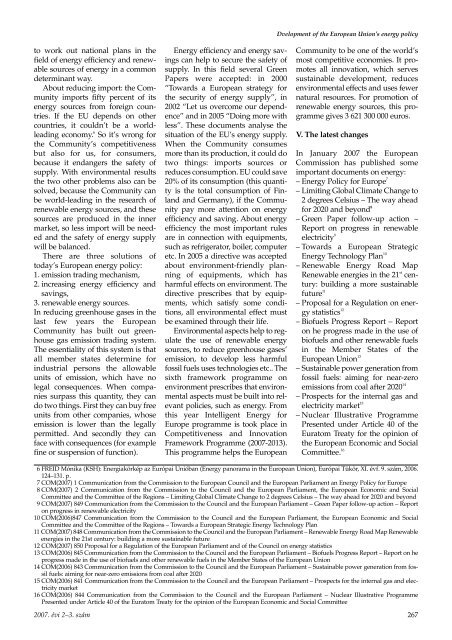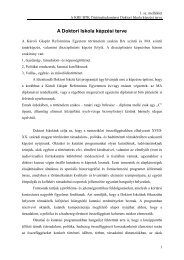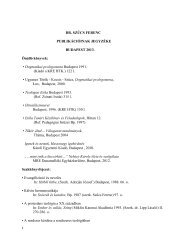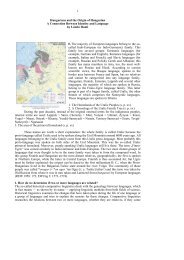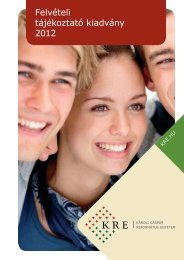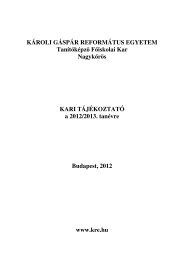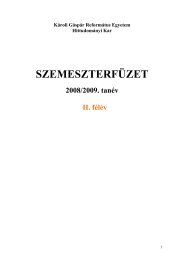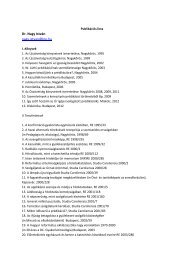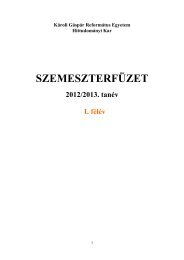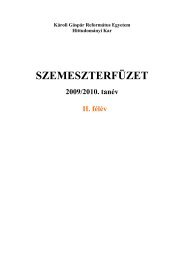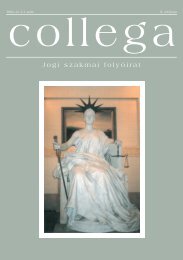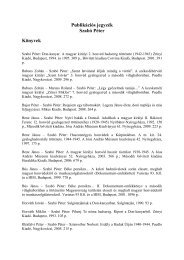collega - Károli Gáspár Református Egyetem
collega - Károli Gáspár Református Egyetem
collega - Károli Gáspár Református Egyetem
Create successful ePaper yourself
Turn your PDF publications into a flip-book with our unique Google optimized e-Paper software.
Dvelopment of the European Union’s energy policy<br />
to work out national plans in the<br />
field of energy efficiency and renewable<br />
sources of energy in a common<br />
determinant way.<br />
About reducing import: the Community<br />
imports fifty percent of its<br />
energy sources from foreign countries.<br />
If the EU depends on other<br />
countries, it couldn’t be a worldleading<br />
economy. 6<br />
So it’s wrong for<br />
the Community’s competitiveness<br />
but also for us, for consumers,<br />
because it endangers the safety of<br />
supply. With environmental results<br />
the two other problems also can be<br />
solved, because the Community can<br />
be world-leading in the research of<br />
renewable energy sources, and these<br />
sources are produced in the inner<br />
market, so less import will be needed<br />
and the safety of energy supply<br />
will be balanced.<br />
There are three solutions of<br />
today’s European energy policy:<br />
1. emission trading mechanism,<br />
2. increasing energy efficiency and<br />
savings,<br />
3. renewable energy sources.<br />
In reducing greenhouse gases in the<br />
last few years the European<br />
Community has built out greenhouse<br />
gas emission trading system.<br />
The essentiality of this system is that<br />
all member states determine for<br />
industrial persons the allowable<br />
units of emission, which have no<br />
legal consequences. When companies<br />
surpass this quantity, they can<br />
do two things. First they can buy free<br />
units from other companies, whose<br />
emission is lower than the legally<br />
permitted. And secondly they can<br />
face with consequences (for example<br />
fine or suspension of function).<br />
Energy efficiency and energy savings<br />
can help to secure the safety of<br />
supply. In this field several Green<br />
Papers were accepted: in 2000<br />
“Towards a European strategy for<br />
the security of energy supply”, in<br />
2002 “Let us overcome our dependence”<br />
and in 2005 “Doing more with<br />
less”. These documents analyse the<br />
situation of the EU’s energy supply.<br />
When the Community consumes<br />
more than its production, it could do<br />
two things: imports sources or<br />
reduces consumption. EU could save<br />
20% of its consumption (this quantity<br />
is the total consumption of Finland<br />
and Germany), if the Community<br />
pay more attention on energy<br />
efficiency and saving. About energy<br />
efficiency the most important rules<br />
are in connection with equipments,<br />
such as refrigerator, boiler, computer<br />
etc. In 2005 a directive was accepted<br />
about environment-friendly planning<br />
of equipments, which has<br />
harmful effects on environment. The<br />
directive prescribes that by equipments,<br />
which satisfy some conditions,<br />
all environmental effect must<br />
be examined through their life.<br />
Environmental aspects help to regulate<br />
the use of renewable energy<br />
sources, to reduce greenhouse gases’<br />
emission, to develop less harmful<br />
fossil fuels uses technologies etc.. The<br />
sixth framework programme on<br />
environment prescribes that environmental<br />
aspects must be built into relevant<br />
policies, such as energy. From<br />
this year Intelligent Energy for<br />
Europe programme is took place in<br />
Competitiveness and Innovation<br />
Framework Programme (2007-2013).<br />
This programme helps the European<br />
Community to be one of the world’s<br />
most competitive economies. It promotes<br />
all innovation, which serves<br />
sustainable development, reduces<br />
environmental effects and uses fewer<br />
natural resources. For promotion of<br />
renewable energy sources, this programme<br />
gives 3 621 300 000 euros.<br />
V. The latest changes<br />
In January 2007 the European<br />
Commission has published some<br />
important documents on energy:<br />
– Energy Policy for Europe 7<br />
– Limiting Global Climate Change to<br />
2 degrees Celsius – The way ahead<br />
for 2020 and beyond 8<br />
– Green Paper follow-up action –<br />
Report on progress in renewable<br />
electricity 9<br />
– Towards a European Strategic<br />
Energy Technology Plan 10<br />
– Renewable Energy Road Map<br />
Renewable energies in the 21 st century:<br />
building a more sustainable<br />
future 11<br />
– Proposal for a Regulation on energy<br />
statistics 12<br />
– Biofuels Progress Report – Report<br />
on he progress made in the use of<br />
biofuels and other renewable fuels<br />
in the Member States of the<br />
European Union 13<br />
– Sustainable power generation from<br />
fossil fuels: aiming for near-zero<br />
emissions from coal after 2020 14<br />
– Prospects for the internal gas and<br />
electricity market 15<br />
– Nuclear Illustrative Programme<br />
Presented under Article 40 of the<br />
Euratom Treaty for the opinion of<br />
the European Economic and Social<br />
Committee. 16<br />
6 FREID Mónika (KSH): Energiakörkép az Európai Unióban (Energy panorama in the European Union), Európai Tükör, XI. évf. 9. szám, 2006.<br />
124–131. p.<br />
7 COM(2007) 1 Communication from the Commission to the European Council and the European Parliament an Energy Policy for Europe<br />
8 COM(2007) 2 Communication from the Commission to the Council and the European Parliament, the European Economic and Social<br />
Committee and the Committee of the Regions – Limiting Global Climate Change to 2 degrees Celsius – The way ahead for 2020 and beyond<br />
9 COM(2007) 849 Communication from the Commission to the Council and the European Parliament – Green Paper follow-up action – Report<br />
on progress in renewable electricity<br />
10 COM(2006)847 Communication from the Commission to the Council and the European Parliament, the European Economic and Social<br />
Committee and the Committee of the Regions – Towards a European Strategic Energy Technology Plan<br />
11 COM(2007) 848 Communication from the Commission to the Council and the European Parliament – Renewable Energy Road Map Renewable<br />
energies in the 21st century: building a more sustainable future<br />
12 COM(2007) 850 Proposal for a Regulation of the European Parliament and of the Council on energy statistics<br />
13 COM(2006) 845 Communication from the Commission to the Council and the European Parliament – Biofuels Progress Report – Report on he<br />
progress made in the use of biofuels and other renewable fuels in the Member States of the European Union<br />
14 COM(2006) 843 Communication from the Commission to the Council and the European Parliament – Sustainable power generation from fossil<br />
fuels: aiming for near-zero emissions from coal after 2020<br />
15 COM(2006) 841 Communication from the Commission to the Council and the European Parliament – Prospects for the internal gas and electricity<br />
market<br />
16 COM(2006) 844 Communication from the Commission to the Council and the European Parliament – Nuclear Illustrative Programme<br />
Presented under Article 40 of the Euratom Treaty for the opinion of the European Economic and Social Committee<br />
2007. évi 2–3. szám<br />
267


